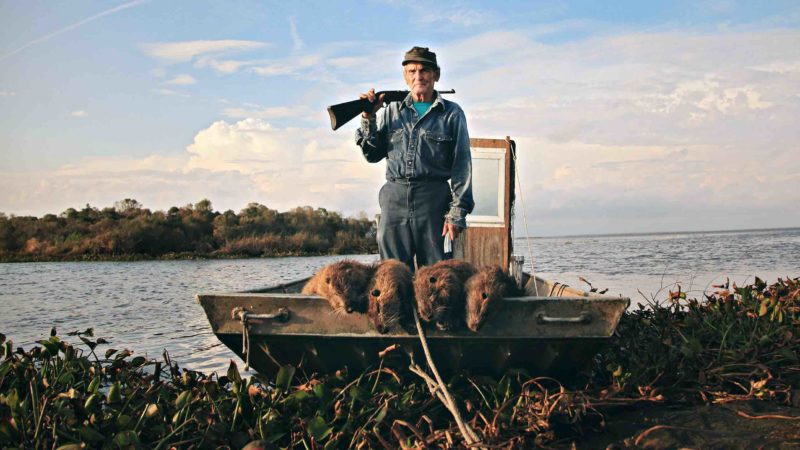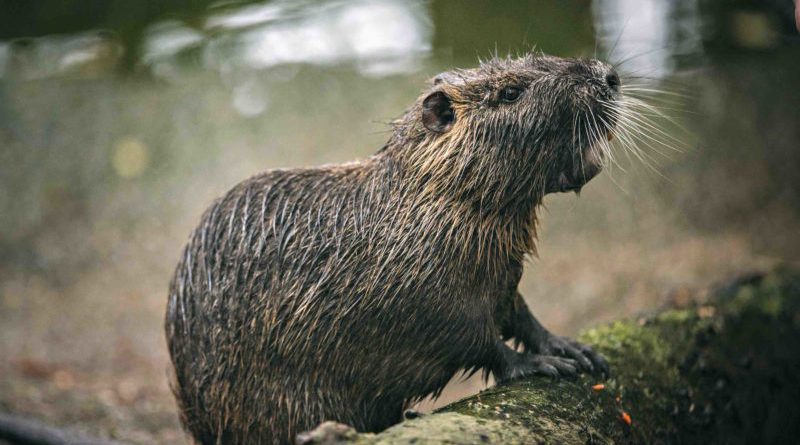INTERVIEW: New documentary dives deep into world of nutria
Photo: Nutria, also known as a swamp rat, is a semi-aquatic rodent native to South America. After being introduced to Louisiana, its destructive feeding behaviors have made this invasive species a scourge of the swamp. Photo courtesy of film’s press site / Provided with permission.
For the uninitiated, a nutria is a large, web-footed rodent with distinctive orange teeth, according to National Geographic. They can be viewed as horrifying large rats or unique mammals found in several different environments around the world.
A new documentary, dubbed Rodents of Unusual Size, looks at a small region south of New Orleans that is inundated with nutria. Locals have embraced the identity of the animals — even naming a baseball team’s mascot after the rodent — but there’s also a lot of frustration over the animals’ destructive habits.
Filmmakers Chris Metzler, Jeff Springer and Quinn Costello grabbed their cameras and headed down to the bayou — specifically Delacroix Island — and told the stories of the people who have to live with the species every single day.
“Chris and I had been curious about the idea because we had read an article or so, and then Quinn had actually gone down to Louisiana just to visit,” Springer said in a recent phone interview. “And a friend of his is working in the Nutria Control Program, and she started to tell him about it: the idea that people were using it for food and using it for clothing. It seemed like such an interesting environmental story that was kind of counterintuitive in a way, where it’s like by getting rid of the animals is actually helping save the wetlands. I think that was what drove us to it, where it was this unique environmental situation where it’s not always easy to find what the solution is, but it definitely wasn’t the conventional environmental story.”
That destruction of the wetlands is a real concern for the communities of coastal Louisiana. Erosion is a reality, and the constant barrage of hurricanes and the chomping teeth of the nutria have not helped matters. To halt the so-called invasion, the state has started a program that pays hunters for each nutria tail they bring in, and sometimes the meat from the dead animal ends up on the dinner plate.
One of the subjects of the film is local Thomas Gonzales, a real find for the filmmaking team.
“Quinn was actually asking around for different nutria hunters, and then someone had told him, ‘Oh, you have to talk to Thomas. He’s the king of the nutria hunters,'” Springer remembers. “He was holding court in the town —this little, tiny town; everyone kind of going to him for advice. It was really apparent that he would be our guy when we had gone down there, and soon after we had gone down there with the camera and everything, we were on his boat. And we were actually filming one of the scenes from the movie, which is about the devastation of the hurricane, and that’s literally a half hour after we all met him. He was really open and the perfect documentary subject in a way, where he doesn’t really care that we’re doing a movie about him at all. He’s just super natural, and I think he just wants to be heard. There’s a certain authenticity that we really enjoyed with him.”

Springer and company were brand new to the world of nutria. They had never seen the animals before heading down to Louisiana to document them, and they didn’t immediately see them on Delacroix Island. For starters, the rodents are generally skittish, and even though they are believed to be increasing in numbers, the little guys (and sometimes not-so-little guys) will often hide when humans are around.
“Even when there’s a ton of them, they’re always hiding,” he said. “It makes for a challenge for the filmmaking process because I was shooting the movie, and it was really difficult to get really good shots of them. That was always a challenge.”
After spending the 71-minute duration of Rodents of Unusual Size with these animals, audiences may change their perception, much like the locals south of New Orleans. They can be seen as a menace, and some will never change that perception. But others have embraced the critters.
“We went in first thinking they’re this menace, this horrible thing, and then you start to see how it has been integrated into the culture,” the director said. “It’s a mascot for the baseball team. Someone has one as a pet, and even Thomas has a nutria as a pet. So even though they’re killing all these nutria, they have a certain fondness for them as well. … In the very end of the production, we had found a trained nutria that could do a few extra shots for us, and that nutria is a very special animal in the sense that you can hold her and pet her, really able to get up close and really see a nutria up close like that. Especially then, it was just like, OK, this issue is a lot more complicated than it seems. They’re not all bad in a lot of ways.”
As far as eating the animals, Springer did take part in the practice, but it’s not everyone’s favorite form of delicacy.
“It kind of depends on the person,” he said with a laugh. “Some people really like eating them. Like Kermit Ruffins, who is a jazz musician in the movie, he’s really big on eating wild food, and so he’s into it. There’s a lot of new chefs that think it’s a great food source, too. … They’re vegetarian. There’s no chemicals, so they’re actually a really healthy meat. It really varies from person to person. Some people are disgusted by it, and some people love it. Thomas Gonzalez, he doesn’t eat it, but his son does. And when we were down there, we had eaten it a few times, and it can be done quite well. It depends on who cooks it.”
By John Soltes / Publisher / John@HollywoodSoapbox.com
Rodents of Unusual Size is now playing in movie theaters. Click here for more information.

